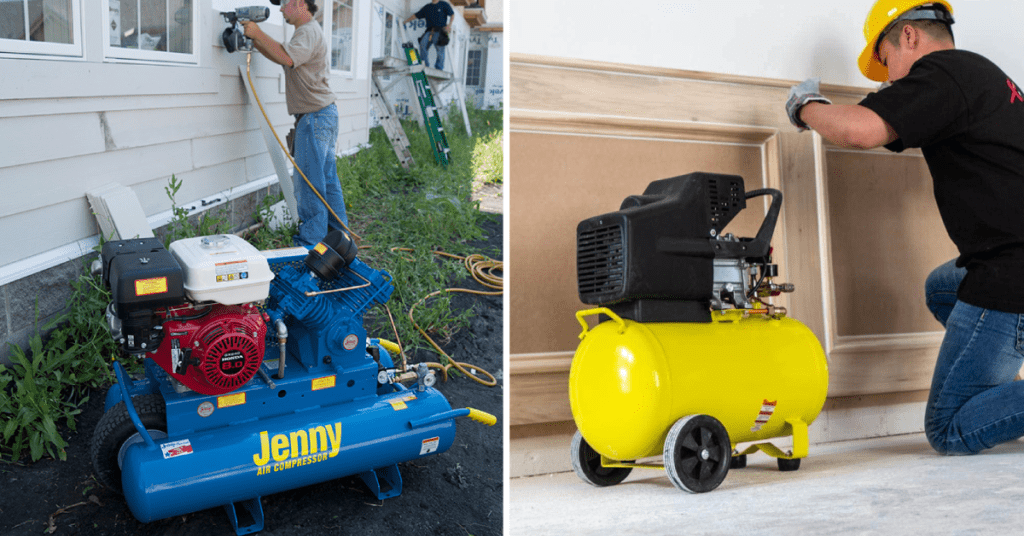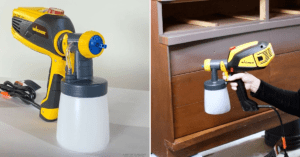How to Use an Air Compressor for the First Time
Are you a first-time user of an air compressor? If the answer is yes, then look no further! In this blog post, we’ll be guiding you through how to use an air compressor for the first time from start to finish like a pro. Whether you’re planning on using it in the workshop or completing any kind of DIY task or home improvement job, learning how to operate and maintain an air compressor will give you even greater control over your projects. So let’s get started on your journey to legal and safe usage of an air compressor!

Understand the components of an air compressor
Before we start using an air compressor, it’s important for us to first familiarize ourselves with the various components that make up the machine. This will not only help you operate the device properly but also troubleshoot any issues that may arise during its use. Some of the key parts of an air compressor include:
- Tank: This is where compressed air is stored and released through the outlet valve.
- Pump: The pump is responsible for compressing the air and filling up the tank.
- Pressure switch: It helps to regulate air pressure in the tank by turning on and off the motor when needed.
- Motor: The motor powers the pump, allowing it to compress air into the tank. It also powers other parts of the air compressor such as fans and gauges.
- Gauges: They display the pressure levels in the tank and at the outlet, allowing you to monitor and adjust accordingly.
Tools and Materials Needed for First-Time Use
To use an air compressor for the first time, you’ll need to gather a few tools and materials beforehand. These include:
- Safety gear: This includes safety glasses, gloves, and earplugs.
- Air hose: To connect the air compressor to your pneumatic tools.
- Pneumatic tools: Such as nail guns or impact wrenches that require compressed air to operate.
- Power cord: Make sure the compressor is connected to a grounded outlet using an appropriate power cord.
- Lubricant: To keep the pump running smoothly and prevent rusting of internal components. Check the user manual for the recommended type of lubricant.
- Air filter: To prevent dust and debris from entering the compressor’s tank and pump.
Safety Precautions for First-Time Use
Now that you have all the necessary tools and materials, it’s important to observe some safety measures before using an air compressor for the first time:
- Read the user manual: Familiarize yourself with the specific model of your air compressor and follow any instructions or warnings provided.
- Wear appropriate safety gear: Protect your eyes, hands, and ears from potential hazards.
- Check for any damages or leaks: Inspect the air compressor and its components for any signs of damage or wear and tear. Do not use a faulty machine.
- Keep children and pets away: Air compressors can be loud and dangerous, so make sure they are kept at a safe distance.
3 Easy Steps for Setting Up Your Air Compressor
Step 1: Choosing a Suitable Location
To begin, carefully evaluate and choose a suitable location for setting up and operating your air compressor. Seek out a well-ventilated area that is clear of obstacles and preferably has a nearby power source dedicated to the compressor. It is crucial to ensure that the surface is not only flat and stable but also capable of safely supporting the weight of the compressor without any risk of tipping or shifting. Furthermore, consider the noise level generated by the compressor and its proximity to sensitive areas or neighboring properties.
Step 2: Assembling the Compressor
To start assembling the air compressor, carefully gather all the required components. Consult the detailed instructions provided by the manufacturer to ensure a smooth and precise assembly process. Begin by securely attaching the handle and wheels, establishing a sturdy foundation for the compressor. Next, connect the air hose and power cord, ensuring proper alignment and secure fastening. Take the time to double-check and confirm the correct placement of other parts, such as the pressure gauge and safety valve. Once the assembly is complete, conduct a thorough final inspection to ensure that every component is correctly installed and ready for use.
Step 3: Plugging In and Powering On
Double-check that the compressor is turned off and plug it in. Once connected, ensure that the power switch of the compressor is set to “Off” before turning on the power outlet. If your air compressor comes with an automatic start-stop function, once you turn it on, it will begin filling up the tank automatically until it reaches its designated pressure level. However, if your compressor lacks this function, you will need to manually start the pump by flipping the power switch to “On.”
2 Steps for Adjusting the Pressure Settings
Step 1: Setting the Pressure Regulator
Before setting the pressure regulator, make sure that your compressor is turned off. The pressure regulator helps regulate the amount of air being dispersed through the outlet valve and into your tools. Start by turning the knob on top of the regulator counterclockwise to decrease the pressure or clockwise to increase it.
Step 2: Checking the Pressure Gauge
After setting the desired pressure on the regulator, turn on the compressor and observe the pressure gauge. If it falls below your desired pressure, adjust the regulator as needed until you reach your desired level. As a general rule, do not exceed the maximum pressure limit indicated on the tank or user manual to avoid any potential hazards.
2 Easy Steps for Using the Air Compressor for the First Time
Step 1: Connecting Air Tools
To start using your air compressor, you’ll need to connect the appropriate pneumatic tools using an air hose. Make sure that the connections are secure and free of any leaks. Additionally, ensure that all tools are turned off before connecting them to the air compressor.
Step 2: Turning on the Compressor
Once your tools are connected, turn on the compressor and wait for it to reach the desired pressure level. Once it does, you can start using your tools as needed. Remember to periodically check and adjust the pressure settings if necessary.
Step 3: Operating the Compressor Safely
While using the air compressor, it’s important to follow safety precautions such as wearing appropriate gear and keeping a safe distance from the machine. Additionally, never leave the compressor unattended while it is running and always turn it off when not in use.
By following these simple steps and taking necessary precautions, you can easily set up and use an air compressor for the first time.
Shutting Down and Storing the Air Compressor
Turning Off the Compressor
Once you are done using the air compressor, turn it off and unplug it from the power source. Release any remaining pressure in the tank by opening the drain valve and disconnecting all tools and hoses.
Disconnecting Air Tools
Before storing the compressor, it is important to take a few extra steps to ensure its longevity. Start by thoroughly cleaning all air tools and hoses, and removing any dirt or debris that may have accumulated during use. Once cleaned, disconnect the air tools and hoses from the compressor, making sure to do so gently and with care.
Draining Condensation
To prevent any potential damage from moisture buildup, it is crucial to drain the condensation from the tank after each use. This can be done by opening the drain valve and letting all the excess water and air escape.
Storing the Compressor Properly
To ensure that your air compressor remains in good condition and is ready for use the next time, it’s vital to store it properly. Keep it in a clean and dry area, away from extreme temperatures or direct sunlight. Additionally, consider covering it with a tarp or sheet to protect it from dust and debris. Remember to regularly inspect and maintain your compressor to prolong its lifespan and ensure safe operation. Lastly, always refer to the manufacturer’s instructions for specific storage guidelines and recommendations.
Maintenance and Cleaning for Optimal Performance
Regular maintenance and cleaning are essential for keeping your air compressor in top shape. Here are some helpful tips to help you maintain optimal performance:
- Keep the compressor clean and free of any dirt or debris.
- Regularly check and replace air filters as needed.
- Inspect and tighten all bolts, screws, and connections regularly.
- Keep an eye out for any signs of wear and tear, such as leaks or cracks.
- Drain condensation from the tank after each use.
- Lubricate moving parts, such as pistons and valves regularly.
By following these simple maintenance practices, you can ensure that your air compressor remains in good working condition for years to come.
Troubleshooting Common Issues for Smooth Operation
While air compressors are generally reliable and easy to use, you may encounter some common issues that can affect their performance. Here are a few troubleshooting tips for some of the most common problems:
- Low pressure: Check the regulator settings and adjust as needed.
- Leakages: Inspect all connections for any leaks and tighten or replace them as necessary.
- Overheating: Allow the compressor to cool down before restarting, and regularly check and clean any air intake filters.
- Excessive noise: Check for loose or worn parts and tighten or replace as needed, also consider using sound-reducing materials around the compressor.
If you encounter any other issues not mentioned above, always refer to the manufacturer’s instructions or seek professional assistance.
FAQs for Air Compressors
Conclusion
Air compressors are incredibly useful tools, but they must be used properly and maintained regularly to function optimally. With this blog post, you now understand the key components of an air compressor, what tools and safety precautions you need to use it, as well as how to set and adjust pressure settings. It is important to check the pressure gauge when using the compressor for the first time, and always remember to turn off the power switch and disconnect the tools before shutting down. Lastly, make sure your air compressor is stored safely in a dry place away from extreme temperatures.
Now that you know all these things, go forth with confidence and enjoy using your air compressor! Once you get accustomed to it, don’t forget to perform regular maintenance and cleaning of your equipment for maximum performance.






